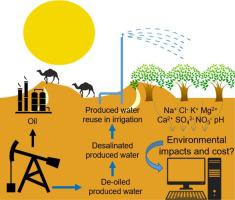当前位置:
X-MOL 学术
›
Agric. Water Manag.
›
论文详情
Our official English website, www.x-mol.net, welcomes your
feedback! (Note: you will need to create a separate account there.)
Towards agro-environmentally sustainable irrigation with treated produced water in hyper-arid environments
Agricultural Water Management ( IF 5.9 ) Pub Date : 2021-01-01 , DOI: 10.1016/j.agwat.2020.106449 Alban Echchelh , Tim Hess , Ruben Sakrabani , Stephane Prigent , Alexandros I. Stefanakis
Agricultural Water Management ( IF 5.9 ) Pub Date : 2021-01-01 , DOI: 10.1016/j.agwat.2020.106449 Alban Echchelh , Tim Hess , Ruben Sakrabani , Stephane Prigent , Alexandros I. Stefanakis

|
Abstract Produced water (PW) is the main waste stream generated from oil and gas extraction. Nowadays, half of the global PW volume is managed through environmentally controversial and expensive disposal practices, such as re-injection through deep wells. In dry areas such as in the Arabian Peninsula, PW could be reused to irrigate crops, creating environmental, economic and social value. However, the quality of most PWs remains challenging as their high salinity, sodicity and alkalinity can degrade soil fertility and crop yield. Mitigating these negative impacts is costly as it requires specific PW treatment and irrigation management. Thus, the environmental sustainability and the cost of irrigation with PW are uncertain. The aims of this paper was to assess the agro-environmental sustainability of irrigating crops with PW in hot and hyper-arid climate and to estimate the operating cost of reusing PW for irrigation in order to compare this PW management approach to PW disposal in terms of environmental impacts and financial cost. To this end, a soil-water model was used to simulate irrigation of jojoba (Simmondsia chinensis) with oilfield-PW. Different irrigation strategies combining over-irrigation, PW blending and desalination were tested to preserve the soil structural stability and the crop yield. The operational costs of identified sustainable scenarios were estimated using a cost analysis. In this case study, the simulations showed that using an irrigation volume up to ∼390 % of the crop water needs with a blend composed of raw and desalinated PW in a 2:1 ratio could preserve the soil structural stability and the crop yield. However, for irrigation, the least-cost option was to mix raw and desalinated PW in a 1:4 ratio and to reduce the irrigation amount to just meet the crop water needs. Although the cost of managing PW in irrigation remains up to 2.5 times higher than PW disposal, this practice might be competitive considering the crop value generated and the increasing need for sustainable alternatives to PW disposal.
中文翻译:

在超干旱环境中使用处理过的采出水实现农业环境可持续灌溉
摘要 采出水 (PW) 是石油和天然气开采过程中产生的主要废物流。如今,全球一半的 PW 量是通过环境有争议且昂贵的处置方法来管理的,例如通过深井回注。在阿拉伯半岛等干旱地区,PW 可重新用于灌溉作物,创造环境、经济和社会价值。然而,大多数 PW 的质量仍然具有挑战性,因为它们的高盐度、高碱度和高碱度会降低土壤肥力和作物产量。减轻这些负面影响的成本很高,因为它需要特定的 PW 处理和灌溉管理。因此,环境可持续性和使用 PW 灌溉的成本是不确定的。本文的目的是评估在炎热和超干旱气候下用 PW 灌溉作物的农业环境可持续性,并估算重复使用 PW 进行灌溉的运营成本,以便将这种 PW 管理方法与 PW 处置进行比较环境影响和财务成本。为此,使用土壤-水模型来模拟用油田-PW 灌溉荷荷巴 (Simmondsia chinensis)。结合过度灌溉、PW 混合和脱盐的不同灌溉策略进行了测试,以保持土壤结构稳定性和作物产量。已确定的可持续情景的运营成本是使用成本分析估算的。在本案例研究中,模拟表明,使用高达作物需水量的 390% 的灌溉量以及由原始和脱盐 PW 组成的混合物,在 2 中:1 的比例可以保持土壤结构的稳定性和作物产量。然而,对于灌溉,成本最低的选择是以 1:4 的比例混合原始和脱盐的 PW,并减少灌溉量以满足作物用水需求。虽然管理灌溉中的 PW 的成本仍然比 PW 处置高出 2.5 倍,但考虑到产生的作物价值以及对 PW 处置的可持续替代方案日益增长的需求,这种做法可能具有竞争力。
更新日期:2021-01-01
中文翻译:

在超干旱环境中使用处理过的采出水实现农业环境可持续灌溉
摘要 采出水 (PW) 是石油和天然气开采过程中产生的主要废物流。如今,全球一半的 PW 量是通过环境有争议且昂贵的处置方法来管理的,例如通过深井回注。在阿拉伯半岛等干旱地区,PW 可重新用于灌溉作物,创造环境、经济和社会价值。然而,大多数 PW 的质量仍然具有挑战性,因为它们的高盐度、高碱度和高碱度会降低土壤肥力和作物产量。减轻这些负面影响的成本很高,因为它需要特定的 PW 处理和灌溉管理。因此,环境可持续性和使用 PW 灌溉的成本是不确定的。本文的目的是评估在炎热和超干旱气候下用 PW 灌溉作物的农业环境可持续性,并估算重复使用 PW 进行灌溉的运营成本,以便将这种 PW 管理方法与 PW 处置进行比较环境影响和财务成本。为此,使用土壤-水模型来模拟用油田-PW 灌溉荷荷巴 (Simmondsia chinensis)。结合过度灌溉、PW 混合和脱盐的不同灌溉策略进行了测试,以保持土壤结构稳定性和作物产量。已确定的可持续情景的运营成本是使用成本分析估算的。在本案例研究中,模拟表明,使用高达作物需水量的 390% 的灌溉量以及由原始和脱盐 PW 组成的混合物,在 2 中:1 的比例可以保持土壤结构的稳定性和作物产量。然而,对于灌溉,成本最低的选择是以 1:4 的比例混合原始和脱盐的 PW,并减少灌溉量以满足作物用水需求。虽然管理灌溉中的 PW 的成本仍然比 PW 处置高出 2.5 倍,但考虑到产生的作物价值以及对 PW 处置的可持续替代方案日益增长的需求,这种做法可能具有竞争力。











































 京公网安备 11010802027423号
京公网安备 11010802027423号